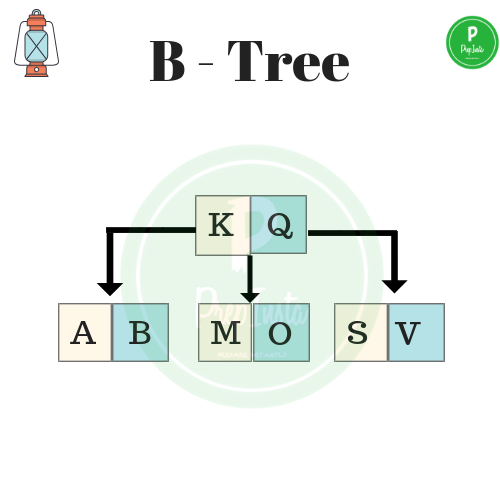B- Trees
Introduction to B- Trees
A B – Tree can be defined as a multi-way search tree of order m such that it follows the conditions stated:
- All the internal nodes (except the root node) have at least m/2 children and at most m children.
- The non – leaf root node may have at most m non empty child and at least two child nodes.
- In a B- Tree, the root node is the only node that can exist without no child nodes.
- If a node has m children then it must have (m – 1) values. All these values of a particular node are in increasing order.
- All the values of a node that appear on the leftmost child of the node are smaller than the first value of that node. Similarly, all the values that appear on the rightmost child of a node are greater than the last value of that node.
- If a and b are any two ith and (i+1)th values of the node , where x < y, then all the values appearing on the (i+1)th sub tree of the that node are greater than x and less than y.
- All the leaf nodes should appear on the same level.
- The primary goal to use a B-tree is to reduce the number of disk access. Majority of tree operations such as searching, traversal ,insertion, etc, take O(n) time, where n is the height of the tree.
- A B-Tree of degree T can have –
- T-1 minimum keys.
- 2T-1 maximum keys.

Operations in a B-Tree
- Insertion.
- Deletion
Representation of B- Tree
The structure of a node in B-Tree can be represented as follows:
- struct btree_node
- {
- int c;
- int val[M + 1];
- struct btree_node *child[M + 1]
- };
- Here c represents the number of children a particular node can have.
- Array val represents the values of the node stored in it.
- Array child stores the address of child nodes.
- The macro M signifies the maximum number of values a node can hold.

Creation of a B-Tree:
Let us consider a B-Tree of order 5. It means we can have a maximum number of 4 values that any node can hold.
For reference we see the given image. we can see that any node can have at most 4 values.
But if in any case we are given the degree of a tree; for instance consider t = 2, then,
- Minimum number of keys that a tree can hold can be calculated as
- min_key = t – 1=> 2 – 1 => min_key = 1
- Maximum number of keys that a tree can hold can be calculated as
- max_key = 2t – 1 => 2(2) – 1 => 4 – 1 => max_key = 3
Step 1:
The first three elements 20 , 30 , 35 are added to a node.

Step 2:
The element 85 is added to the node. Now if we jump back to the previous section we can see that a B-tree with degree t=2 can have at most 3 key values. Thus the node is split from the median.
Note: How to calculate median for splitting the node-
- Let x be a given key values in a node.
- n be the length of the node .
- Meadian = n[x] / 2.
Hence here we can see the length n[x] = 4.
Thus, Median = n[x] / 2 => 4 / 2 = 2.
This means that the node will be split from the second key of the node.

Step 3:
As the node is split 30 becomes the new root node of the tree.

Step 4:
The element 5 is inserted.

Step 5:
The element 10 is inserted.

Step 6:
The element 40 is inserted

Step 7:
The element 55 is added to the node.

Step 8:
- To conserve the degree of the tree, we need to split the node where 55 was added. To do so we calculate the median which comes out to be 2.
- The node is split from the 2nd key. 40 moves upwards to the root node.
- The tree structure is shown as follows.

Step 9:
The elements 38 and 60 are added to the B-Tree.

Step 10:
- The element 25 is added to the node. The node has to split as each node in this tree can have at most 3 keys.
- The node is split from the Median, i.e, 2.

Step 11:
The node is split from the 2nd key. Thus, 10 moves upwards to the parent / root node.

Step 12:
The elements 7 and 78 are added to the B-Tree

Step 13:
- As the node is split the element 60 moves upward towards the parent / root node.
- Now, again we can see that the root node is to be split because each node can hold at most 3 keys.

Step 14:
- Again, we calculate the median of the node. The median can be calculated as follows,
- Median = n[x] / 2.
- Median = 4 / 2.
- Median = 2.
- The node is split from the 2nd key which moves upwards and becomes the new root of the tree. The tree structure that follows is shown as follows,

- The final B-Tree after the concurrent insertion and splitting is shown as follows.
- This B-Tree fulfills all the properties of a B-Tree.
- Each node has either at least 1 key or at most 3 keys.
- Any node with number of keys exceeding the given number is split and re-arranged accordingly.




Thanks for perfect examples